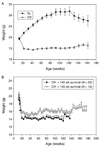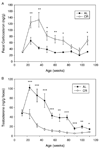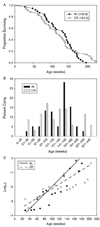Does caloric restriction extend life in wild mice? - PubMed (original) (raw)
Does caloric restriction extend life in wild mice?
James M Harper et al. Aging Cell. 2006 Dec.
Abstract
To investigate whether mice genetically unaltered by many generations of laboratory selection exhibit similar hormonal and demographic responses to caloric restriction (CR) as laboratory rodents, we performed CR on cohorts of genetically heterogeneous male mice which were grandoffspring of wild-caught ancestors. Although hormonal changes, specifically an increase in corticosterone and decrease in testosterone, mimicked those seen in laboratory-adapted rodents, we found no difference in mean longevity between ad libitum (AL) and CR dietary groups, although a maximum likelihood fitted Gompertz mortality model indicated a significantly shallower slope and higher intercept for the CR group. This result was due to higher mortality in CR animals early in life, but lower mortality late in life. A subset of animals may have exhibited the standard demographic response to CR in that the longest-lived 8.1% of our animals were all from the CR group. Despite the lack of a robust mean longevity difference between groups, we did note a strong anticancer effect of CR as seen in laboratory rodents. Three plausible interpretations of our results are the following: (1) animals not selected under laboratory conditions do not show the typical CR effect; (2) because wild-derived animals eat less when fed AL, our restriction regime was too severe to see the CR effect; or (3) there is genetic variation for the CR effect in wild populations; variants that respond to CR with extended life are inadvertently selected for under conditions of laboratory domestication.
Figures
Fig. 1
(A) Longitudinal trends in body weights of ad libitum (AL) and caloric restriction (CR) wild-derived mice. (B) Longitudinal trends in CR animals that are long- [> 143 weeks (1000 days)] or short-lived (< 143 weeks).
Fig. 2
Fecal (A) corticosterone and (B) testosterone concentrations in caloric restriction (CR) vs. ad libitum (AL) mice. ***P ≤ 0.001; **0.001 < P ≤ 0.01; *0.01 < P < 0.05 for differences between CR and AL at equivalent times.
Fig. 3
Longevity of ad libitum (AL) and caloric restriction (CR) animals. (A) Comparative survival shows no statistical difference. Numbers in parenthesis are mean values for each group. (B) Distribution of deaths in the two groups. CR animals show more early deaths but fewer later deaths than the AL group. (C) Age-specific hazard rates and Gompertz plots for the two groups. Despite the lack of a difference in survival between the groups, there is a statistical difference in Gompertz parameters (P = 0.014).
Similar articles
- Caloric restriction and the aging process: a critique.
Sohal RS, Forster MJ. Sohal RS, et al. Free Radic Biol Med. 2014 Aug;73:366-82. doi: 10.1016/j.freeradbiomed.2014.05.015. Epub 2014 Jun 2. Free Radic Biol Med. 2014. PMID: 24941891 Free PMC article. Review. - Are mice calorically restricted in nature?
Austad SN, Kristan DM. Austad SN, et al. Aging Cell. 2003 Aug;2(4):201-7. doi: 10.1046/j.1474-9728.2003.00053.x. Aging Cell. 2003. PMID: 12934713 - Telomerase reverse transcriptase synergizes with calorie restriction to increase health span and extend mouse longevity.
Vera E, Bernardes de Jesus B, Foronda M, Flores JM, Blasco MA. Vera E, et al. PLoS One. 2013;8(1):e53760. doi: 10.1371/journal.pone.0053760. Epub 2013 Jan 22. PLoS One. 2013. PMID: 23349740 Free PMC article. - Caloric restriction and aging: studies in mice and monkeys.
Anderson RM, Shanmuganayagam D, Weindruch R. Anderson RM, et al. Toxicol Pathol. 2009 Jan;37(1):47-51. doi: 10.1177/0192623308329476. Epub 2008 Dec 15. Toxicol Pathol. 2009. PMID: 19075044 Free PMC article. Review. - Genotype and age influence the effect of caloric intake on mortality in mice.
Forster MJ, Morris P, Sohal RS. Forster MJ, et al. FASEB J. 2003 Apr;17(6):690-2. doi: 10.1096/fj.02-0533fje. Epub 2003 Feb 5. FASEB J. 2003. PMID: 12586746 Free PMC article.
Cited by
- Better Living through Chemistry: Caloric Restriction (CR) and CR Mimetics Alter Genome Function to Promote Increased Health and Lifespan.
Gillespie ZE, Pickering J, Eskiw CH. Gillespie ZE, et al. Front Genet. 2016 Aug 18;7:142. doi: 10.3389/fgene.2016.00142. eCollection 2016. Front Genet. 2016. PMID: 27588026 Free PMC article. Review. - Wild-derived mouse stocks: an underappreciated tool for aging research.
Harper JM. Harper JM. Age (Dordr). 2008 Sep;30(2-3):135-45. doi: 10.1007/s11357-008-9057-0. Epub 2008 May 30. Age (Dordr). 2008. PMID: 19424863 Free PMC article. - Caloric restriction and the aging process: a critique.
Sohal RS, Forster MJ. Sohal RS, et al. Free Radic Biol Med. 2014 Aug;73:366-82. doi: 10.1016/j.freeradbiomed.2014.05.015. Epub 2014 Jun 2. Free Radic Biol Med. 2014. PMID: 24941891 Free PMC article. Review. - Life span extension in mice by food restriction depends on an energy imbalance.
Sohal RS, Ferguson M, Sohal BH, Forster MJ. Sohal RS, et al. J Nutr. 2009 Mar;139(3):533-9. doi: 10.3945/jn.108.100313. Epub 2009 Jan 13. J Nutr. 2009. PMID: 19141702 Free PMC article. - Transcriptional profiling identifies strain-specific effects of caloric restriction and opposite responses in human and mouse white adipose tissue.
Swindell WR, List EO, Berryman DE, Kopchick JJ. Swindell WR, et al. Aging (Albany NY). 2018 Apr 29;10(4):701-746. doi: 10.18632/aging.101424. Aging (Albany NY). 2018. PMID: 29708498 Free PMC article.
References
- Austad SN. Life extension by dietary restriction in the bowl and doily spider, Frontinella pyramitela. Exp. Gerontol. 1989;24:83–92. - PubMed
- Austad SN, Kristan DM. Are mice calorically restricted in nature? Aging Cell. 2003;2:201–207. - PubMed
- Berry RJ, Bronson FH. Life history and bioeconomy of the house mouse. Biol. Rev. Camb. Philos. Soc. 1992;67:519–550. - PubMed
- Bertrand HA, Lynd FT, Masoro EJ, Yu BP. Changes in adipose mass and cellularity through the adult life of rats fed ad libitum or a life-prolonging restricted diet. J. Gerontol. 1980;35:827–835. - PubMed
- Birt DF, Przybyszewski J, Wang W, Stewart J, Liu Y. Identification of molecular targets for dietary energy restriction prevention of skin carcinogenesis: an idea cultivated by Edward Bresnick. J. Cell. Biochem. 2004;91:258–264. - PubMed
Publication types
MeSH terms
Substances
LinkOut - more resources
Full Text Sources
Other Literature Sources
Medical


